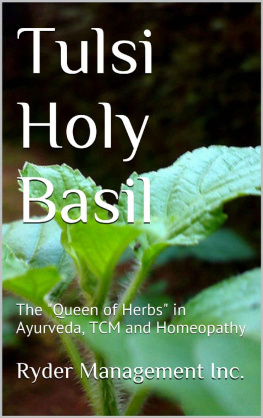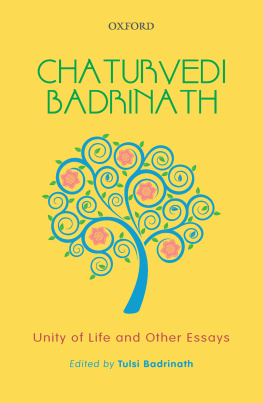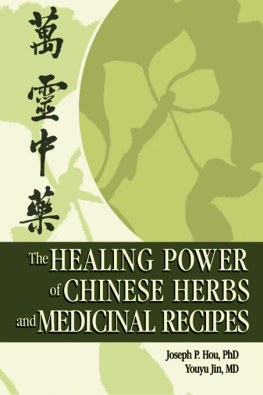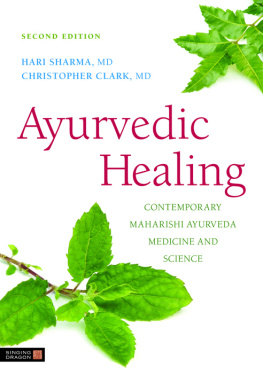Tulsi Holy Basil
The Queen of Herbs in Ayurveda, TCM and Homeopathy
By Ryder Management Inc.
Copyright 2014 by Ryder Management Inc.
All Rights Reserved
In order to facilitate assisting others with information respecting alternatives in health care, this book introduces another very important and cherished medicinal herb used for over five thousand years in Ayurveda medicine. The publisher has made every effort possible to ensure that the information contained in this book is accurate, complete and up to date at press time. However, the publisher, under advisement, does not assume and hereby disclaims any liability to any party for any loss, damager or disruption caused by errors or omissions, whether such errors or omissions result from negligence, accident or any other cause.
Table of Contents
Introduction
Ayurvedic or Ayurveda medicine is a system of natural healing originating in India over five thousand years ago. Often called the Mother of All Healing , Ayurveda actually means the Science of Life. Both Tibetan medicine and Traditional Chinese Medicine (TCM) have their roots in Ayurveda, as does Homeopathy practices in the West. In addition, early Greek medicine also includes concepts taken from Ayurvedic texts dating back thousands of years.
Ayurvedic healing includes, but is not limited to the use of herbs, nutrition and body detoxification and cleansing. Ayurvedic practice seeks to restore an balance and harmony in the body, which then enables the body to heal itself thus promoting health and longevity.
Western allopathic medicine tends to focus on symptoms and disease and uses drugs and surgery as a method of removing pathogens and diseased tissues (including organs) from the body. Unfortunately, due to the toxic nature inherent in pharmaceutical drugs, more often than note, this method of treatment has a tendency to weaken the bodys immune system.
An important goal of Ayurveda is to identify a persons ideal state of balance, determine if and where a person is out of balance and subsequently provide a combination of herbs, diet and other forms of natural therapies with the aim at restoring balance, to regain optimal health and vitality.
Used in Ayurveda medicine for thousands of years this herb, referred to as the Queen of Herbs called Tulsi Holy Basil (or Tulsi, or Holy Basil) is one of Indias most sacred herbs due to its distinct healing abilities. While basil is found throughout the world, Tulsi Holy Basil is indigenous to the Indian subcontinent and is the topic of this book.
History

Tulsi, also spelled Tulasi, has been cultivated in India for over five thousand years (as already mentioned) and has been included in key historical documents including the Rigveda (Book of Eternal Knowledge) believed to have been developed around 5,000 BC; an early text on traditional Indian medicine known as Caraka Samhita (discovered around 1500 BC); along with the Nighantu Adarsha , another historic medical text. In all cases, it was found that Tulsi was one of the top medicinal herbs used in ancient times.
The Holy Basil plant, believed to protect against misfortune as well as an aide to the heavens, and many traditional Hindu homes display a holy basil plant in their garden or planted in an earthenware pot also prominently displayed.
This plant represents harmony, serenity, purity and good fortune and due to its spiritual significance, holy basil roots are used in Hindu rosary beads on which they count the number of recitations of their deitys name. This plant also has a history in traditional Hindu weddings and funerals. The Tulsi plant is thought to open the heart and mind, and bestow love, compassion, faith and devotion. (tulsiplant.org)
In addition to religion, culture and medicinal uses, Tulsi is highly regarded in the culinary industry due to its aroma, taste and nutritional value. This plant can be prepared as a calming tea or a thirst-quenching juice both of which are rich in aroma and flavor and stimulating, healthy nutritional benefits.
Tulsi Varieties
Holy Basil belongs to the genus Ocimum in the Lamiaceae or mint family. Ocimum is a genus which includes many species of both perennial and annual herbs and shrubs. There are three distinct varieties of Tulsi as follows:
Rama Tulsi (Ocimum sanctum or tenuiflorum);Krishna or Shyama Tulsi (Ocimum tenuiflorum or sanctum);Vana Tulsi (Ocimum gratissimum).
Sweet basil is scientifically known as Ocimum basilicum, also contains many powerful benefits but wont be discussed in this book.
Although each of the above varieties have specific use in ayurveda, it is Rama and Krishna (both related) thought to be used the most for medicinal purposes. However, recent studies show Vana (Ocimum Gratissimum) as and effective treatment for breast cancer.
The parts of the plant generally used include the leaves, seeds and dried roots.
In all varieties, Tulsi is a bushy shrub that grows to about 18 inches in height. Its leaves are oval and serrated with colors ranging from light green to dark purple, depending on the variety. In the wild, Tulsi is an annual but it can be kept as a perennial by trimming it before the seeds or formed.
Rama Tulsi (Ocimum sanctum)

Rama Tulsi , also known as Green Leaf Tulsi is a short annual, heavily flowered variety of Tulsi and was the variety originally introduced to North America. Known for its mellow and somewhat cooling taste, Rama Tulsi has a stronger fragrance than the other varieties of Tulsi Holy Basil. Rama is the most common type found in North America, it is also found in China, Nepal, Brazil and India.
Krishna Tulsi (Ocimum Tenuiflorum)

Krishna Tulsi , also known as Shyam or Purple Leaf Tulsi has a distinct peppery, sharp taste. It also has a purple tinge to its darker colored leaves. This variety tested highest in concentrations of adaptogenic triterpenoic compounds.
Vana Tulsi (Ocimum gratissimum)

Vana Tulsi is thought to be the original bush basil and the original great adaptogen. It is very high in eugenol which is an essential oil also found in cloves. Eugenol has many uses including dentistry, perfume, and medicine. This variety is found in the Himalayas, throughout the plains of India, and throughout Africa and Asia.
Medicinal Qualities
Tulsi Holy Basil is loaded with antioxidants, which are powerful nutrients that protect the body from free radicals and preventing oxidative cell damage. Free radicals are reactive molecules that steal electrons from the body. It is becoming common knowledge that antioxidants play a key role in maintaining health along with reducing the risk of all sorts of disorders including heart disease, Alzheimers, Parkinsons, cancer and may even slow down the aging process.
Tulsis unique chemistry is very complex but offers benefits considered beyond that offered from other herbs. Tulsi contains hundreds of phytochemicals containing health-promoting properties.
The synergies offered by the phytochemicals found in Holy basil contain potent antioxidant, adaptogenic and immune enhancing benefits that fight stress, promote better health and also the following:
Supports and builds immune system;
Next page















